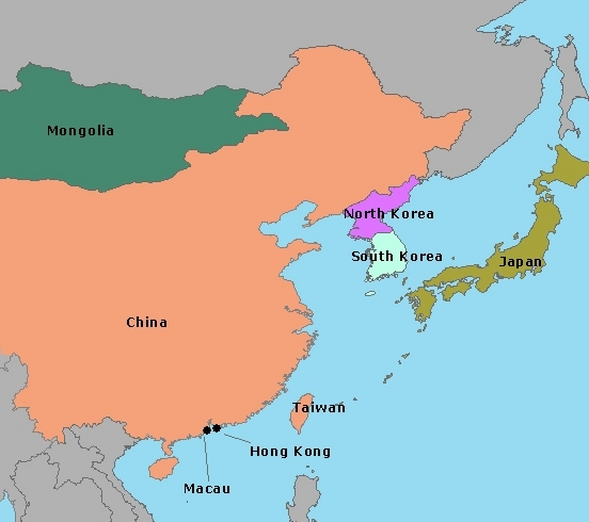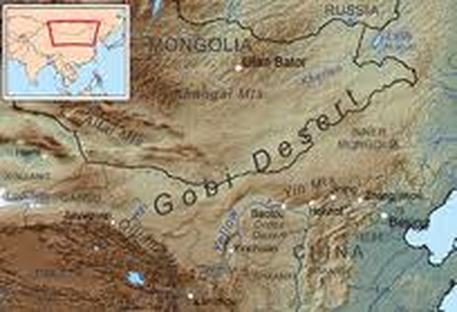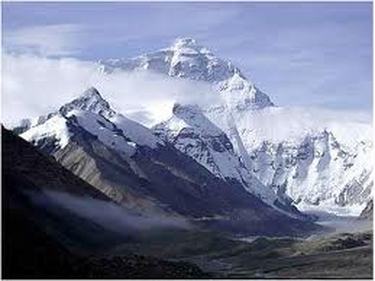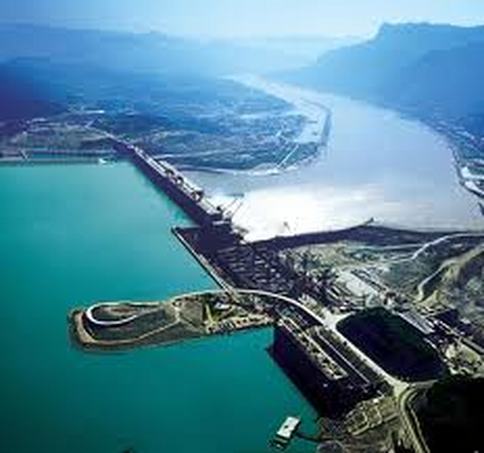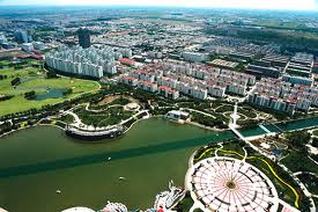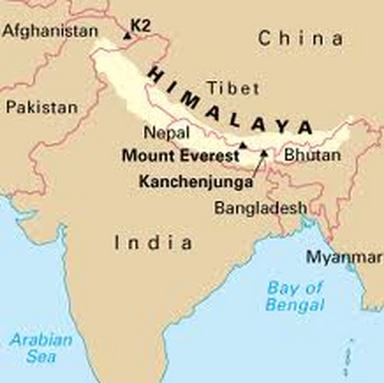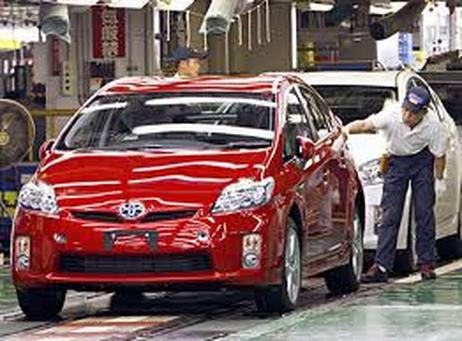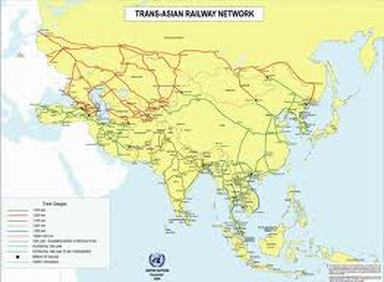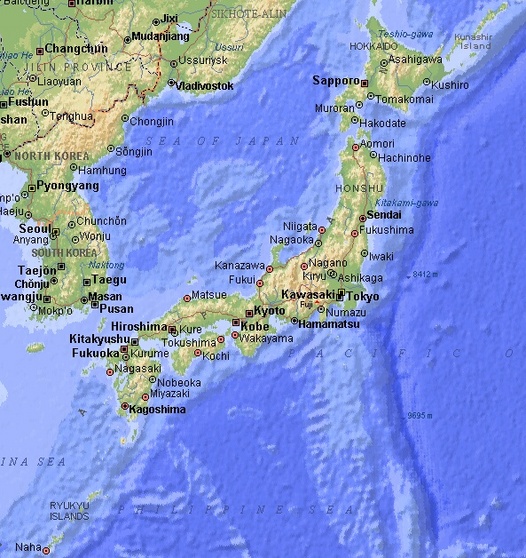Exploring Geography
East Asia
Number of Countries within Region: 6
China, Japan, Mongolia, North Korea, South Korea and Taiwan
Physical Features
Gobi Desert
The Gobi desert is located in Inner Mongolia. Gobi, meaning “waterless place” receives less than eight inches of rainfall each year. The desert is approximately 1.3 million sq. km. in size and lies on a plateau rising above
3 – 5,000 feet above sea level. The land is home to mainly Mongols. The desert has a cold climate as it lies in the shadows of the Himalayan Mountains. The Gobi is currently the fifth largest desert in the world and continues to grow larger each year due to desertification.
Fun Fact: Many ancient fossils have been found in the Gobi, including the first Dinosaur egg. (Gobi Desert, 2010.)
The Gobi desert is located in Inner Mongolia. Gobi, meaning “waterless place” receives less than eight inches of rainfall each year. The desert is approximately 1.3 million sq. km. in size and lies on a plateau rising above
3 – 5,000 feet above sea level. The land is home to mainly Mongols. The desert has a cold climate as it lies in the shadows of the Himalayan Mountains. The Gobi is currently the fifth largest desert in the world and continues to grow larger each year due to desertification.
Fun Fact: Many ancient fossils have been found in the Gobi, including the first Dinosaur egg. (Gobi Desert, 2010.)
Plateau of Tibet
The Tibetan Plateau is the largest and highest area in the world. This was created nearly 50 million years ago when the tectonic plates collided, causing India to collide into the Asian continent. The rock of the plates was similar and the plates were unable to defeat each other in turn the land was pushed straight up in the air, causing the ridged peaks of the Himalayas and The Plateau of Tibet. The average height of the peaks is 13,000 feet. The continental crust is thickest beneath the Plateau of Tibet. The Plateau is located in Western China, and home to the Tibetan people. Tibet and Qiughai are the two provinces located on the plateau.
The Tibetan Plateau is the largest and highest area in the world. This was created nearly 50 million years ago when the tectonic plates collided, causing India to collide into the Asian continent. The rock of the plates was similar and the plates were unable to defeat each other in turn the land was pushed straight up in the air, causing the ridged peaks of the Himalayas and The Plateau of Tibet. The average height of the peaks is 13,000 feet. The continental crust is thickest beneath the Plateau of Tibet. The Plateau is located in Western China, and home to the Tibetan people. Tibet and Qiughai are the two provinces located on the plateau.
Three Gorges Dam
The Three Gorges Dam is considered to be the largest Dam in the world. The dam is nearly 600 feet high and 1.4 miles wide. The dam was built to generate electricity and improve the control over flooding. There has been attention given to concerns such as the quality of construction due to cracks that already exist and the potential damage caused by future earthquakes. The costs of this project have been very hard to forecast due to the massive relocation of residents (approx. 1.3 residents) and cities (13 major cities) along with pollutants and erosion due to the rising water levels of the reservoir.
The Three Gorges Dam is considered to be the largest Dam in the world. The dam is nearly 600 feet high and 1.4 miles wide. The dam was built to generate electricity and improve the control over flooding. There has been attention given to concerns such as the quality of construction due to cracks that already exist and the potential damage caused by future earthquakes. The costs of this project have been very hard to forecast due to the massive relocation of residents (approx. 1.3 residents) and cities (13 major cities) along with pollutants and erosion due to the rising water levels of the reservoir.
North China Plain
The North China Plain used to be home to forests, but the population began to encroach on its boundaries and caused years of deforestation. Today the plains are the most densely populated area in East Asia. The climate is arid, and wheat is the main crop produced due to the dry climate. The Huang Hu River stretches throughout the plain acting as a great resource for agriculture and transportation.
The North China Plain used to be home to forests, but the population began to encroach on its boundaries and caused years of deforestation. Today the plains are the most densely populated area in East Asia. The climate is arid, and wheat is the main crop produced due to the dry climate. The Huang Hu River stretches throughout the plain acting as a great resource for agriculture and transportation.
Himalayan Mountains
The Himalayas started to form nearly 40 – 50 million years ago caused by tectonic plate movement colliding in India and Eurasia. Stretching between India and Tibet, the Himalayas are nearly 2,900 km long, covering 230,000 sq. km. of land. They are located in China, Bhutan, Nepal, Pakistan and India. The mountain range includes more than 110 peaks, with elevations as high as 24,000 feet. Himalayas are considered the greatest and highest mountain range in the world, with Mt. Everest as the tallest mountain in the world.
Climate
East Asia has 2 climate zones
The Interior portion of this region (or in the west portion) the climate is very dry. Land temperatures rise and fall much faster than water temperatures. The winters are intensely dry and the summers are a combination of extremely dry and hot. The Mongolian and Tibet Plateaus, the basin and the mountains of Xinjiang and Qinghai are located in this part of the region. Most of these areas are covered in grassland.
Most of the east part of the region is along the coast. They experience a very wet (monsoon) climate. This climate is caused by the very cold winters in the Eurasian landmass and the warm summers of the oceans.
During the winter, cold air from the Mongolian Plateau sweeps over the area causing the long and cold winters. Some areas are protected from these long harsh winters by the east-west ranges of the Qin Ling, which brings in warmer air from the seas.
During the summer the pacific brings in warm wet air into the east creating a very wet season. The Zhu Jiang basin, Chang Jiang basin, and the North China Plain receive an abundance of rain, along with warm temperatures. Farmers took over this area for the well-watered land. They have destroyed most of the forests and replaced them with agriculture.
The Interior portion of this region (or in the west portion) the climate is very dry. Land temperatures rise and fall much faster than water temperatures. The winters are intensely dry and the summers are a combination of extremely dry and hot. The Mongolian and Tibet Plateaus, the basin and the mountains of Xinjiang and Qinghai are located in this part of the region. Most of these areas are covered in grassland.
Most of the east part of the region is along the coast. They experience a very wet (monsoon) climate. This climate is caused by the very cold winters in the Eurasian landmass and the warm summers of the oceans.
During the winter, cold air from the Mongolian Plateau sweeps over the area causing the long and cold winters. Some areas are protected from these long harsh winters by the east-west ranges of the Qin Ling, which brings in warmer air from the seas.
During the summer the pacific brings in warm wet air into the east creating a very wet season. The Zhu Jiang basin, Chang Jiang basin, and the North China Plain receive an abundance of rain, along with warm temperatures. Farmers took over this area for the well-watered land. They have destroyed most of the forests and replaced them with agriculture.
Resources
Japan has overcome its defeat in World War II, rising with one of the healthiest economic developments in the world. They put a plan in place setting up industrial enterprises and shops abroad to sell their goods. They were very careful while creating their new infrastructure making sure the latest innovation was used, keeping them at the forefront of their competition. The little amount of natural resources within the region did not affect Japan as they have created an extensive exporting industry, building automobiles, heavy equipment, cameras, computers, and video and audio equipment (Pulsipher, Pulsiper, 2008.)
In the early 1990's things started to slow down with Japan and East Asia's other "state - aided market economies." Then the financial crisis in the late 1990’s caused even more disturbance and has not fully recovered yet today.
In the early 1990's things started to slow down with Japan and East Asia's other "state - aided market economies." Then the financial crisis in the late 1990’s caused even more disturbance and has not fully recovered yet today.
Environmental Issues
Air Pollution
Air Pollution is more prevalent in the more densely populated areas, and is the worst in northeastern China because of the close proximity of the homes to the industrial facilities. The Industrial air output totals 18% in china alone. Coal burning is the primary cause of the Industrial air pollution. It is blamed for serious respiratory problems among residents. SO2 and suspended particles distributed into the air are 10 times higher than the level that the World Health Organization (WHO) allows.
Flooding
Extreme and devastating flooding happens along the rivers caused by the monsoons of the summer. Many people are left homeless during this season. Dikes, dams and reservoirs along with man-made lakes have been created to help this problem. China has built some of the largest dams in the world. (Three Gorges as an example)
Drought
In other areas of this region drought occurs. The drought can cause much more devastation. The continued farming and dense population use what is left in water reserves, leaving many without water and in the most extreme cases without food.
Water pollution
Due to the extremely high dense population and the severe flooding there is a huge problem with water safety. Nearly 1/3 of the population lacks safe drinking water. Raw sewage and chemicals have polluted most the waterways. Health problems due to the water pollution, is valued at $4 billion a year.
Air Pollution is more prevalent in the more densely populated areas, and is the worst in northeastern China because of the close proximity of the homes to the industrial facilities. The Industrial air output totals 18% in china alone. Coal burning is the primary cause of the Industrial air pollution. It is blamed for serious respiratory problems among residents. SO2 and suspended particles distributed into the air are 10 times higher than the level that the World Health Organization (WHO) allows.
Flooding
Extreme and devastating flooding happens along the rivers caused by the monsoons of the summer. Many people are left homeless during this season. Dikes, dams and reservoirs along with man-made lakes have been created to help this problem. China has built some of the largest dams in the world. (Three Gorges as an example)
Drought
In other areas of this region drought occurs. The drought can cause much more devastation. The continued farming and dense population use what is left in water reserves, leaving many without water and in the most extreme cases without food.
Water pollution
Due to the extremely high dense population and the severe flooding there is a huge problem with water safety. Nearly 1/3 of the population lacks safe drinking water. Raw sewage and chemicals have polluted most the waterways. Health problems due to the water pollution, is valued at $4 billion a year.
Population Patterns
This region is the most heavily populated region in the world. China holds 1/5 of the world’s population alone (1.3 million). Due to poor terrain, less than 20% of the land is habituated causing 90% of the population to cluster mainly in the east. China has a policy that only 1 child is allowed per family. With such a low birth rate, China has an older population.
Role of Gender
Women are generally held responsible for most of the domestic duties. This includes being the caretaker for their children, spouses and elderly relatives. They are also the sole caretaker of the housework. Well educated women tend to stay home, because it is nearly impossible to balance home duties with the long, demanding duties at work. Commutes are extremely long as well with the very over crowed communities.
Work consists of very long hours for both men, and employed women. It is considered “un-loyal” to reject overtime and employers discourage time off to assist with family needs.
Work consists of very long hours for both men, and employed women. It is considered “un-loyal” to reject overtime and employers discourage time off to assist with family needs.
Religion
In East Asia, Confucianism is practiced as a religion. Many people refer to Confucianism more as a philosophy than a religion, while others describe it as a religion similar to Buddhism and Zoroastrianism. Originating in China, it soon began to spread to Korea, Taiwan and Vietnam. Most people who practice the teaching of Confucius also follow the Chinese traditional religion, which is described as a blend of Confucianism, Buddhism, and Taoism. Eventually Confucian philosophy was part of all aspects in the Chinese society. The values under this belief system include respecting parents, government officials, to show courtesy, loyalty, knowledge and integrity in daily life. The oldest male of the family holds the “seat of authority” and he is responsible for the wellbeing of his family. The other family members are delegated their positions in the families pyramid of power by their age and sex.
Transportation
The railway is a very common form of transportation in East Asia, along with road and airways. Nearly 50% of the transportation in this in this region is done on the railway. Nearly 90% of the population use some form of public transportation. The condition of the roads in this region is poor, but extensive work is being done to improve them.
The waterways are generally used for shipping traffic. Japan has a very extensive exporting infrastructure and there is quite a bit of transport coming in and out of this region via these waterways.
The waterways are generally used for shipping traffic. Japan has a very extensive exporting infrastructure and there is quite a bit of transport coming in and out of this region via these waterways.
Country of Focus
Japan
Japan attacked US forces in 1941 (Pearl Harbor) America responded by entering into World War II. The U.S troops soon occupied much of East and Southeast Asia. Japan was defeated, after its defeat and later they recovered to become an economic power and an ally of the US. Japan succeeded in a steady climb of economic growth until the economic downturn of the early 1990’s hit. Even with the slowdown, they still remained a major economic power (CIA. 2011.)
Japan is a chain of islands in Eastern Asia located between the North Pacific Ocean and the Sea of Japan. The total land mass is 377,915 sq. km., with a population of 126,475,664 (July 2011 est.) The median age is 44.3 years old, with a life expectancy for men of 78.9 yr. and 85.7 years old for women.
Japan attacked US forces in 1941 (Pearl Harbor) America responded by entering into World War II. The U.S troops soon occupied much of East and Southeast Asia. Japan was defeated, after its defeat and later they recovered to become an economic power and an ally of the US. Japan succeeded in a steady climb of economic growth until the economic downturn of the early 1990’s hit. Even with the slowdown, they still remained a major economic power (CIA. 2011.)
Japan is a chain of islands in Eastern Asia located between the North Pacific Ocean and the Sea of Japan. The total land mass is 377,915 sq. km., with a population of 126,475,664 (July 2011 est.) The median age is 44.3 years old, with a life expectancy for men of 78.9 yr. and 85.7 years old for women.
Agriculture
In 1970, a law was passed by the “responsibility system” giving decision making rights back to the landowner. China is now a major exporter for high-value agriculture products to other surrounding countries. It is encouraged to produce enough to help supply urban areas and also for exporting. They have started preserving fresh fruits, vegetables, fish, and animal products for exporting. Land space for agriculture is running low, causing worry among the farmers.
References
Aldean A. (2011.) The Tibetan Plateau. Retrieved from
http://geology.about.com/od/structureslandforms/a/tibetanplat.htm
CIA. (2011). Japan. The World Factbook. Retrieved from
https://www.cia.gov/library/publications/the-world-factbook/geos/ja.html
Confucianism. (1995) Religious Tolerance. Retrieved from
http://www.religioustolerance.org/confuciu.htm
Gobi Desert Facts. (2010.) Gobi Desert Retrieved from http://gobidesert.org/content/facts
North China Plain. (2011). In Encyclopedia Britannica. Retrieved from http://www.britannica.com/EBchecked/topic/419130/North-China-Plain
Three Gorges Dam. International Rivers. Retrieved from
http://www.internationalrivers.org/china/three-gorges-dam
